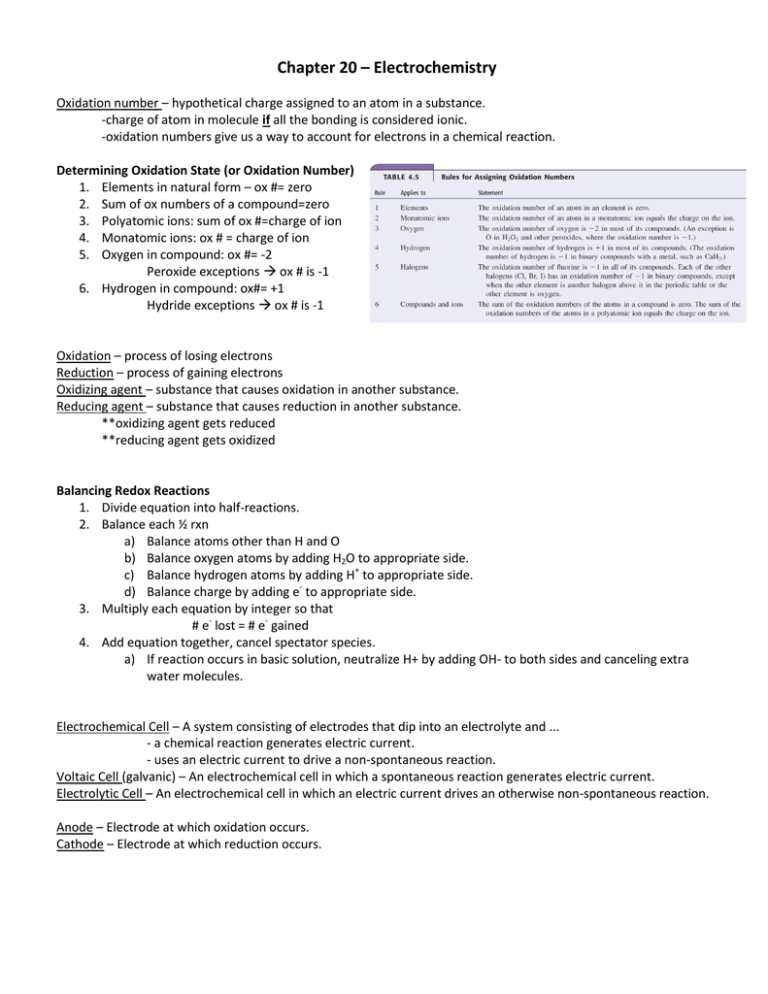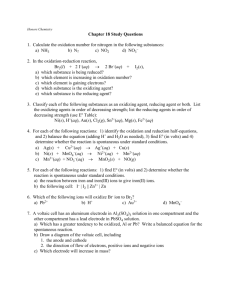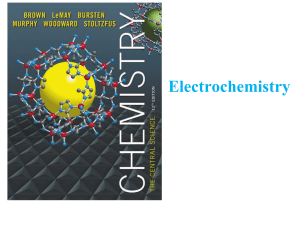Chapter 20 – Electrochemistry
advertisement

Chapter 20 – Electrochemistry Oxidation number – hypothetical charge assigned to an atom in a substance. -charge of atom in molecule if all the bonding is considered ionic. -oxidation numbers give us a way to account for electrons in a chemical reaction. Determining Oxidation State (or Oxidation Number) 1. Elements in natural form – ox #= zero 2. Sum of ox numbers of a compound=zero 3. Polyatomic ions: sum of ox #=charge of ion 4. Monatomic ions: ox # = charge of ion 5. Oxygen in compound: ox #= -2 Peroxide exceptions ox # is -1 6. Hydrogen in compound: ox#= +1 Hydride exceptions ox # is -1 Oxidation – process of losing electrons Reduction – process of gaining electrons Oxidizing agent – substance that causes oxidation in another substance. Reducing agent – substance that causes reduction in another substance. **oxidizing agent gets reduced **reducing agent gets oxidized Balancing Redox Reactions 1. Divide equation into half-reactions. 2. Balance each ½ rxn a) Balance atoms other than H and O b) Balance oxygen atoms by adding H2O to appropriate side. c) Balance hydrogen atoms by adding H+ to appropriate side. d) Balance charge by adding e- to appropriate side. 3. Multiply each equation by integer so that # e- lost = # e- gained 4. Add equation together, cancel spectator species. a) If reaction occurs in basic solution, neutralize H+ by adding OH- to both sides and canceling extra water molecules. Electrochemical Cell – A system consisting of electrodes that dip into an electrolyte and ... - a chemical reaction generates electric current. - uses an electric current to drive a non-spontaneous reaction. Voltaic Cell (galvanic) – An electrochemical cell in which a spontaneous reaction generates electric current. Electrolytic Cell – An electrochemical cell in which an electric current drives an otherwise non-spontaneous reaction. Anode – Electrode at which oxidation occurs. Cathode – Electrode at which reduction occurs. Voltaic cell notation is an abbreviated way of describing a voltaic cell. 1. All phase boundaries are indicated with a vertical line. 2. The salt bridge is indicated by a double vertical line. 3. The anode is written first (on the left), then the cathode on the right. ( )| ( ) || ( )| ( ) Standard Cell Potentials and Standard Electrode Potentials Cell Potential ( ) – the potential difference between the electrodes of a voltaic cell. – the strength of the reducing agent's e- pushing combined with the strength of the oxidizing agents e- pulling. – Also called Electromotive Force (EMF) 1J 1V – Unit for cell potential is volt. 1C Standard Cell Potential ( ) – the cell potential (or EMF) of a voltaic cell operating under standard state conditions. Standard Electrode Potential ( ) – the electrode potential when the solutes are at standard state conditions. -standard electrode potentials are given in Table 19.1 **Calculation of cell potentials can be done using electrode potentials Strength of Oxidizing and Reducing Agents • The more (+) the reduction potential – The stronger the reduction – The better the oxidizing agent (F2, H2O2, and MnO4- are good oxidizing agents) • The more (-) the reduction potential – The more (+) the oxidation potential – The stronger the oxidation – The better the reducing agent (Li(s) and Mg(s) are good reducing agents) Free Energy and Electrical Potential Nernst Equation – Equation which relates cell potential (or EMF) with concentration of electrolyte at 25 ºC






